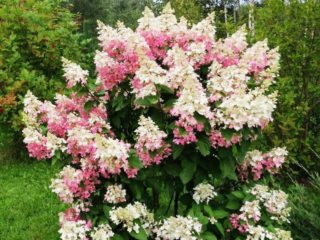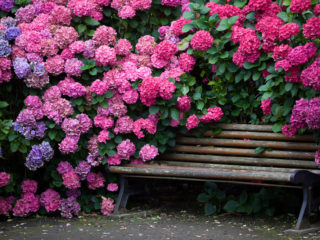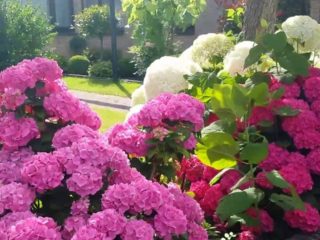Content
Magic Candle is a popular, unpretentious variety of panicle hydrangeas. The shape of her flower brushes resembles a candle. Because of this feature, the variety got its name "Magical Candle", which translates as "Magic Candle". The Magic Candle panicle hydrangea will help gardeners with minimal effort to make the garden romantic and sophisticated.

Hydrangea Magic Candle is read as one of the most beautiful, graceful and spectacular species, thanks to the original inflorescences
Description of hydrangea paniculata Magic Candle
Hydrangea Magic Candle is a lush, compact shrub, 2-3 m high, up to 1.5 m in diameter. The leaves are quite dense and tough, serrated along the edge, dark green in color. Inflorescences are dense, large, pyramidal in shape. They grow strictly vertically. Flowers of the original color, changing as they bloom. In the beginning, they are white-cream or greenish. A little later, the inflorescences of the Magic Candle hydrangea acquire a pale pink tint. At the final stage, the flowers turn bright crimson. The budding season begins in early summer and lasts until mid-autumn.
Hydrangea Magic Candle in landscape design
The exquisite and luxurious Magic Candle hydrangea is one of the most sought-after and popular shrubs used in landscaping and landscaping. This culture is appreciated for its abundant flowering and harmoniously combined colors.
Very often, the Magic Candle hydrangea is used in landscape design to create a flowering hedge. Basically, she either decorates the facade of the garden area, or helps to zone the garden. Hydrangea is also grown in mixborders - complex compositions of flowering perennial plants and shrubs. They also use it as monoplantings, as an independent garden decoration.
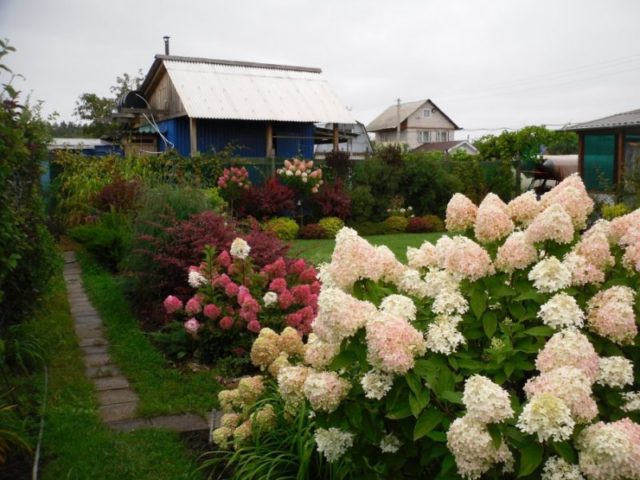
Magical Candle hydrangea looks good in a hedge
Winter hardiness of hydrangea paniculata variety Magic Candle
Hydrangea (magical candle) Magical Candle is a winter-hardy variety adapted for regions with temperate climates. The plant tolerates winter well, in particular, it can withstand a significant drop in air temperature (up to -30 ° C).
Planting and caring for hydrangea Magic Candle
Magical Candle is an unpretentious garden crop. Get beautiful and lush-flowering bushes will allow a minimum set of care-related activities.
Selection and preparation of the landing site
The place for planting hydrangeas Magic Candle should be sunny. Placing seedlings in partial shade is allowed. The shrub prefers fertile soil, neutral or slightly acidic. Alkaline soils must be oxidized by adding peat or potassium salt. Hydrangea Magic Candle does not like waterlogged soils.
Landing rules
The following periods are considered the most optimal time for planting the Magic Candle hydrangea:
- early spring (before bud break);
- autumn (after the end of flowering).
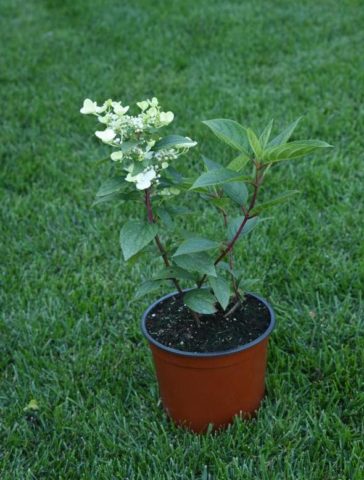
It is not recommended to plant a young flower near similar shrubs and trees, this may cause competition for nutrients and moisture
Step-by-step planting process:
- Prepare the landing pits. Their size should be twice the size of the root system of the seedling. The recommended arrangement of bushes is 1.5x2.0 m.
- Prepare a soil mixture from fertile soil, humus and sand.
- At the bottom of the hole, equip drainage and sprinkle it with prepared soil.
- Place a bush in the hole along with an earthen lump.
- Cover the space around the seedling with soil mixture.
- Tamp the soil tightly around the barrel to prevent air pockets from forming.
- Water the soil abundantly in the trunk circle.
Watering and feeding
Hydrangea Magic Candle is a moisture-loving variety that needs regular and abundant watering. In a hot period, the bushes should be watered often, several times a week, in a moderate period - 4-5 times a month. It is recommended to pour at least 30-50 liters of water under one root. It is recommended to irrigate in the morning and in the evening, when there is no sultry heat.
Additional moisture must be provided to plants in dry autumn. Lack of moisture can significantly reduce the winter hardiness of hydrangeas.
Lush flowering is ensured by regular and correct feeding. Fertilizers should be supplied in the dosage required for the plant. An excess of nutrients can have the opposite effect. Instead of forming beautiful inflorescences, the hydrangea will produce excess foliage, randomly growing in different directions.

The hole should be 2 times larger in volume than the root of the seedling
To feed the bushes, you can use a variety of fertilizers, which are selected, focusing on the stage of crop growth.
Nutrients | Norm for 1 m2soil | |
At the initial stage of growth | ||
Potassium sulphide | 30-35 g | |
Superphosphate | 35-40 g | |
Urea | 20-25 g | |
During budding | ||
Potassium sulphide | 40-45 g | |
Superphosphate | 60-80 g | |
At the end of the growing season | ||
Compost | 15-20 kg | |
Pruning Magic Candle hydrangea
Annual spring pruning allows the bush to form a lush and beautiful crown. It is recommended to conduct it before the start of sap flow. On a young bush, about 10 strong branches are chosen, which are cut by 1/3, leaving 5 buds. Thin and dry shoots are removed completely.
In a mature plant, all branches are cut off in subsequent years (up to 7 cm in height). This procedure is carried out in order to rejuvenate the shrub.
Also, pruning is the prevention of the appearance of pests, since the thickened crown contributes to their reproduction. At the end of the growing season, cut off all faded inflorescences.
Preparing for winter
The variety is quite frost-resistant, therefore, it is necessary to cover the bushes for the winter only when grown in cold climatic regions, in areas with a significant decrease in winter temperatures, dropping to 25-29 ° C. This rule applies to adult plants. Young seedlings need insulation, regardless of the region of cultivation. For shelter, you can use any mulching materials or branches of conifers.
Reproduction
You can reproduce hydrangeas in the following ways:
- cuttings;
- layering.
To get layering near, side shoots are added to the mother bush. They are placed in specially prepared grooves. In the spring-autumn period, they are regularly looked after - watered and fed. In winter, the layers are covered.With the onset of spring, they are separated from the bush and sent for growing in a place as protected as possible from the scorching sun.
Cutting procedure:
- Cuttings (15-20 cm) are separated at the tops of the shoots.
- They are treated with a growth stimulant.
- Placed in well-moistened soil, deepening by 2 buds.
- Watering.
- Fertilize.
- Shelter for the winter.
Diseases and pests
Hydrangea paniculata Magical Candle has good immunity to diseases and pests, but sometimes the bushes are affected by powdery mildew and aphids. Fungal diseases develop due to high humidity and sudden temperature changes.
To combat fungal diseases, biological preparations are used (Fitosporin, Baktofit, Topaz).
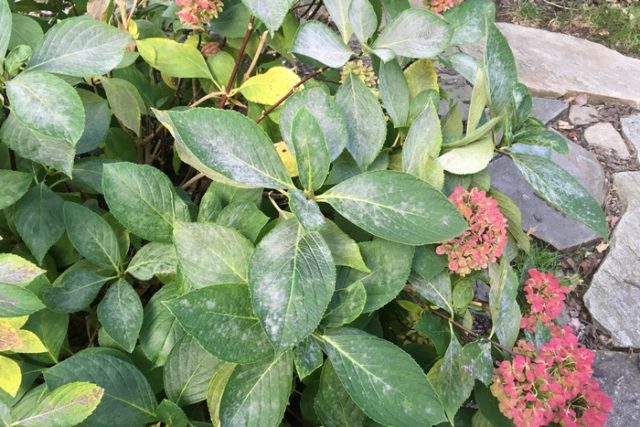
Signs of powdery mildew are curled leaves covered with a white, flour-like coating.
Signs of the appearance of aphids are deformation and wilting of flowers, as well as the presence of puncture marks from bites on the foliage.
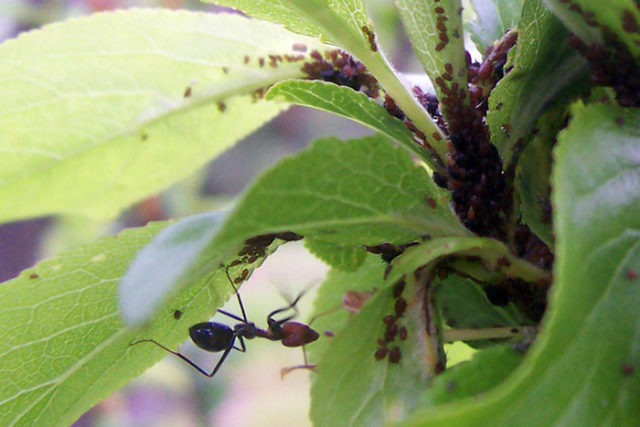
The destruction of garden pests is caused by insecticides
Conclusion
Hydrangea Magic Candle is a perennial, lush garden plant. The shrub pleases with its spectacular beauty from the beginning of summer until the very frosts. Care for this culture requires minimal. Even a novice gardener can plant this shrub in his garden and enjoy its beauty.
